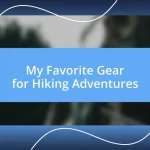Key takeaways:
- Choose campfire stories based on the audience’s age and mood to ensure the right emotional connection and engagement.
- Utilize storytelling techniques like vivid imagery, tone variation, and audience participation to enhance the experience and keep listeners captivated.
- Incorporate personal experiences and humor in your narratives to create relatable and memorable stories that resonate with the audience.

Choosing the Right Campfire Stories
When it comes to choosing the right campfire stories, I often reflect on what makes a story truly captivating. I remember a night under the stars when my grandfather shared ghost stories from his childhood. The way he delivered each chilling detail left us gripping our marshmallow sticks in anticipation—it’s this mix of suspense and connection that really draws people in.
Think about your audience. Are you gathered with adults reminiscing about their wild youth, or are there children eager for something light-hearted? I once awkwardly shared a spooky tale with a group of kids, only to see their little faces turn pale. It taught me the importance of tailoring the story to match the mood and the age group present.
Emotional resonance is key. One of my favorite stories revolves around a grand adventure I had with friends, filled with laughter and close calls. Every time I share it, I can see the smiles and hear the laughs that come from shared memories—there’s something magical about those moments. What story can you share that evokes similar feelings or nostalgia?

Types of Campfire Stories
There are several types of campfire stories that can cater to different audiences and create the right atmosphere. For instance, spooky tales are perfect for thrilling adventure seekers, often leading to shivers and gasps from the crowd. I remember one night, I shared a story about a haunted cabin, and the flickering flames seemed to dance in eerie agreement with my narrative, heightening the suspense.
On the lighter side, folktales and humorous stories can bring everyone together in laughter, making them ideal for mixed groups. I once spun a whimsical tale about a mischievous raccoon who stole our snacks, and as I mimicked the creature’s antics, my friends burst into uncontrollable laughter—it’s moments like these that spark joy around the fire.
Then there are personal anecdotes—stories grounded in our own experiences. I like to weave tales from my childhood camping trips with family, recalling the time we got lost in the woods. Sharing these intimate memories can forge deeper connections with listeners, as they can relate to the themes of adventure and uncertainty.
| Type of Story | Characteristics |
|---|---|
| Spooky Tales | Designed to thrill, often inducing suspense and fear. |
| Humorous Stories | Light-hearted, focused on laughter and audience engagement. |
| Personal Anecdotes | Relatable, intimate stories that foster a sense of connection. |

Classic Campfire Stories for Kids
Classic campfire stories hold a special charm, particularly for kids who are often brimming with curiosity and imagination. One of my favorites comes from a sunny summer afternoon when we gathered around a glowing campfire. I shared a classic story about a clever rabbit who outsmarted a hungry wolf. The kids were glued to my every word, their eyes wide with excitement as I painted the picture of the rabbit’s daring escape and quick thinking. When I reached the climax—where the rabbit tricks the wolf into chasing his own tail—there were gasps and then bursts of laughter. It reminded me just how powerful storytelling can be to spark joy.
Here are some classic campfire stories that kids adore:
- The Tale of the Three Little Bears: A story of adventure and curiosity, teaching about kindness and respect for others’ belongings.
- Goldilocks and the Three Bears: A whimsical story of choice, consequence, and the idea of finding what feels “just right.”
- The Gingerbread Man: A delightful tale of a cookie that won’t stay put, tapping into themes of freedom and fun.
- The Giving Tree: A beautiful story about selflessness and unconditional love that resonates with young hearts.
- Where the Wild Things Are: An enchanting journey into the imagination, showcasing the importance of dreams and adventure.
Each of these stories provides not just entertainment but also valuable life lessons, making them perfect for sharing by the campfire.

Spooky Campfire Stories for Adults
I love an eerie campfire story that gives everyone goosebumps. One that always sends chills down the spine is the tale of the “Wendigo.” Imagine sitting there with friends, the fire crackling, and I recount this legend of a creature born from greed and hunger, doomed to wander the frozen wilderness. It’s definitely made me reconsider what truly drives human nature. Have you ever felt the haunting silence that envelops when I share that story? It’s like the dark woods around us seem to lean in, eager to listen, and it’s moments like these that truly deepen the experience.
There’s also the classic story of “The Vanishing Hitchhiker.” I remember vividly the reaction of my friends when I told them about a driver who picked up a young woman, only to discover that she left behind nothing but her chilling aura. The way the flames flickered when I described her ghostly visage made the story even more intense. It served as a reminder of the unknown, making me think about the stories hidden within our own lives. Isn’t it fascinating how a simple tale can evoke such strong emotions and set the stage for a night of thrilling discussions?
Then there’s the suspenseful narrative of “The Old Scarecrow.” Picture this: a group of us camping by a field, and as I spoke of a scarecrow that comes to life under the full moon, I noticed our breaths grew shallower. I shared how it watches silently from the edge of a nearby cornfield, only to disappear when approached. Personally, it resonated with me because it put into perspective how some fears are simply shadows of our imagination. In moments like these, you can’t help but wonder—what if those shadows are our real monsters? Isn’t it remarkable how storytelling can stretch the mind and connect us with emotions we didn’t realize we had?

Engaging Storytelling Techniques
Engaging storytelling techniques can transform a simple tale into a mesmerizing experience. One method I often rely on is the use of vivid imagery. When I tell stories, especially around a campfire, I focus on the details—how the firelight dances against my friends’ faces or how the night breeze carries the scent of pine. I’ve noticed that the more sensory details I weave in, the more my audience is drawn in. Don’t you feel more connected to a story when you can almost taste the smoke or hear the branches rustling?
Another technique that I find invaluable is varying my tone and pace. I remember telling a story about a ghostly encounter, and as the plot thickened, I gradually slowed my words, creating a palpable tension. The silence around us felt heavy, and I could see my audience leaning in, hanging on to each word. In contrast, I speed up during exciting moments, making their hearts race just as mine did when I first heard that tale. This rhythm creates a dynamic experience—have you ever noticed how a sudden change in pace can send chills down your spine?
Finally, I’ve realized how impactful audience participation can be. Sharing a personal campfire story is great, but inviting friends to contribute or ask questions makes it even better. I often throw in a question mid-story, like “What do you think happens next?” Their reactions and predictions add layers to the experience, making it feel collaborative. The excitement builds as their imaginations spark, and for me, that moment of shared creativity is nothing short of magical. Could there be a better way to unite everyone around the fire than through the power of storytelling?

Tips for Memorable Story Sharing
I’ve learned that setting the right atmosphere is crucial for memorable story sharing. I often pay close attention to the environment around the campfire—things like the crackling of the flames, the scent of roasting marshmallows, and the starry sky above. Creating this immersive backdrop draws my listeners in, making the storytelling experience almost tangible. Have you ever felt how a certain setting can elevate even the simplest tale into something extraordinary?
One tip I swear by is to use pauses strategically. I remember once sharing a haunting tale about a deserted cabin in the woods. When I reached the most suspenseful moment, I paused, letting the silence linger like a heavy fog. The tension in the air was electric! My friends exchanged glances, the crackle of the fire almost amplified their anticipation. Doesn’t that sense of suspense keep you on the edge of your seat?
Lastly, I can’t stress enough the importance of genuine emotion in storytelling. When I recount stories, I don’t just share facts; I relive them. For instance, when I tell a heartwarming ghost story about a lost love, I allow myself to feel the bittersweet nostalgia, which brings the tale to life in a whole new way. My friends can sense my emotions, creating a shared connection that resonates long after the fire dies down. Doesn’t it make you wonder how storytelling can weave us together in ways words alone never could?

Creating Your Own Campfire Tales
When it comes to creating your own campfire tales, I believe starting with a personal experience can add a unique flavor. For instance, I once spun a yarn about a hike gone awry in the mountains, where I stumbled upon an old, overgrown trail. As I described the mysterious surroundings and my growing panic, I could see my friends’ eyes widen, pulling them closer into the narrative. Have you noticed how sharing your own insecurities or fears can resonate deeply with an audience?
In my opinion, crafting a strong opening line can hook your listeners immediately. I often experiment with something unexpected—like starting with a question: “What would you do if you found a hidden cave on a moonlit night?” This sparks curiosity and gets everyone thinking. They aren’t just passive listeners; they’re drawn in, imagining their own reactions. Doesn’t it feel powerful when you can engage everyone from the very first moment?
Lastly, I find that weaving in elements of humor can create a delightful contrast to serious moments. I recall telling a story about an owl that scared me out of my wits, only to reveal it was just a branch swaying in the wind. The laughter that followed broke the tension, allowing us to bond over that shared moment of levity. How does humor transform stories for you? The blend of excitement and laughter often makes the night around the campfire feel even more unforgettable.














